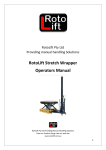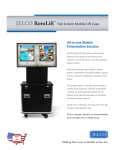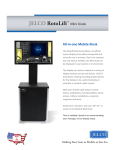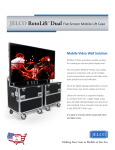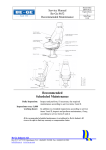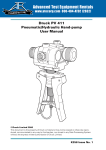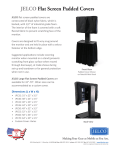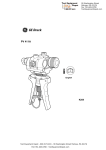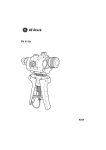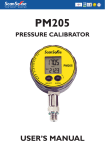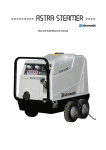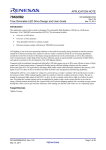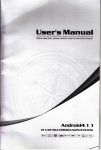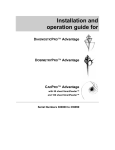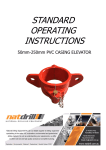Download RotoLift Spring Elevator Operators Manual
Transcript
RotoLift Pty Ltd Providing manual handling Solutions RotoLift Spring Elevator Operators Manual RotoLift Pty Ltd Providing Manual Handling Solutions View our Product Range visit our web site www.rotolift.com.au 0 Contents Page 2 Photo Gallery 3 Introduction, RotoLift Pallet Elevators 4 Safety 5 Relocating your Pallet Elevator 6 Description of Operation Spring selection chart 7 Spring removal or replacement 9 Hazard Identification 11 Elevator Identification 12 Trouble Shooting 13 Spare Parts 14 Maintenance 15 Warranty 16 Consequential Damages 17 Your Records Amendments Merger Spring Elevator Picture Gallery 1 Confined Space Table TopStop Confined Space with internal wheels and foot lock Standard 2 Tonne Flat Bed Top Powered Spring Elevator with Stretch Wrapper Attachment 2 Introduction The Patented RotoLift Product Range, Providing Manual Handling Solutions RotoLiftManual handling equipmentis an Australian Designed, Manufactured and Patented Range of equipment that make manual loading, unloading and stretch wrapping of pallets, safer, faster and more efficient. RotoLift Spring Elevators keep the active layer of the picking or packing load, at or above waist height eliminating, bending and lifting. Our Spring Elevators are a highly effective at reducing the risk of musculoskeletal injuries associated with the picking and packing environment, back strain and injury, are the most common of all work place injuries? Our patent design also makes removing or replacing springs safer and quicker than any of its competitors. RotoLift Pallet Elevators Incorporating our patented design the pallet elevators a based on a scissoraction mechanism, the load is transferred via the patented spring system, wich enables identical capacity springs, 1 to 5 springs to control the applied load (Earlier Rotolift Elevators have up to eight springs to cater for the 2000kg model) Each RotoLift Spring Elevator is supplied with a complete set of springs to suit your required load, a Damper is also incorporated in the design to eliminate any bouncing whilst varying the table top. The turntable allows the operator to rotate the load for even picking or packing with a minimum of stretching or carrying loads. The one piece heavy duty spun top on all models is also a feature especially on the Confined Space Models where the extra return length also provides pinch and catch point protectionThe Base allows easy access for forklifts to relocate the units and on the standard units the base also allows side access for a pallet truck or forklift. Safety 3 The instructions in this manual are not necessarily all inclusive, as RotoLiftcannot anticipate all working environments and our Equipment may be used in. The safety of all personnel directly or indirectly involved inoperating any RotoLift Equipment is of paramount importance, every effort has been made to ensure the integrity of RotoLift equipment operating under normal working condition. Therefore, we have identified as many hazards as possible, but not limited to all hazards that may occur in every work place. RotoLift recommend independent assessment of any equipment and working environment in association with appropriate instructions and S.O.P, s to avoid hazards. RotoLift have adopted the following system of identifying the severity of the hazards associated with RotoLift equipment. “Danger”Immediate hazards that will result in severe personal injury or death. “Warning”Hazardous or unsafe practice which could result in severe personal injury or death. “Caution”Hazardous or unsafe practice which could result in minor personal injury or property damage. PRIOR TO COMMISSINING, FOR YOUR OWN SAFETY AND THE SAFETY OF OTHERS!Please read and follow this instruction manual including all safety instructions and precautions carefully, this manual should be read in its entirety before installing, operating and conducting your own risk assessment. Transit Damage On delivery visually inspect your RotoLift equipment for any signs of signs damage, ensure that all circlips and fasteners are installed transit and havenot been dislodged during.Should there be any evidence of damage contact you equipment supplier immediately. Relocating your Pallet Elevator “Caution”Damage or injury could result if there directions are not followed. To relocate your RotoLiftPallet Elevatorsonly use a suitably approved Pallet Truck or Forklift. 4 The designated lifting points in the base ‘Tyne spaces’ are the only locations that the unit should be lifted from. Never attempt to relocate the Elevator unless it is completely unloaded. RotoLift Pallet Elevatorscannot be lifted by forklift Tyne from under the top of the table. This Picture shows the correct lifting methods and positions using the Tyne locations Descriptionof Operation RotoLift Pallet Elevators Rotolift Pallet Elevators are a patented spring assisted pallet loading platform, the platform height self-adjusts in proportion with the load, giving a consistent picking or packing height for the operator. 5 By keeping a consistent work height, loading and unloading of your product becomes a more efficient, faster, and safer process. The correct number of load rated springs should be install to suit your specific load this will keep the elevator table at the ideal working height The spring selection chart shows the relative loads that your Pallet Elevator can operate within. *Note that new models only have a maximum of 5 springs, your Pallet Elevator will be supplied with five equally rated springs for 1250kg or 2000kg as ordered Spring selection chart Number of Max Kg Loads Springs 2000 Kg Pallet Elevator 1200 Kg Pallet Elevator 1 250 Kg 250 Kg 2 500 Kg 500 Kg 3 750 Kg 750 Kg 4 1000 Kg 1000 Kg 5 1200 Kg 1200 Kg 6 1500 Kg 7 1750 Kg 8 2000 Kg Warning Do not attempt to lock the RotoLift Pallet Elevatorin a compressed but unloaded state, when released the potential energy of the springs could cause serious injury or damage Spring removal or replacement 1. The Pallet Elevator must be completely unloaded ie No Pallets or Product. 2. Process 1 Remove the Damper Pin & Clip. 6 2 Insert the Jacking Key into position. 3 Insert the Jacking Tool into position. Rotate the Jacking Tool up to the Jacking Key, Continue to rotate the Jacking Tool until all preload is removed from the springs (Springs are Loose) 1 Remove the Dampener Clip & Pin 2 Insert the Jacking Key 3 Insert the Jacking Tool 4 Rotate the Jacking Screw Spring removal or replacement 3. Now the Springs are loose remove or replace the desired number of Springs 4. RotoLift recommend that the removing or installing springs should be removed or installed in the following manner, 7 One Spring is to be removed it is recommended that the centre Spring should be removed. Two Springs are to be removed it is recommended that the two outer Springs be removed Three Springs are to be removed the centre and two outside Springs be removed 5. Once the spring have been selected to suit the load remove the jacking bolt and key * Note that all the installed springs are sitting correctly in the upper spring carrier. 6. Replace the Dampener Pin and Clip. 7. Test the Pallet Elevator for the correct working height for the required load . 8. Please note that when removing a pallet either loaded or unloaded from a RotoLift Pallet Elevator a Forklift is required, the pallet must be lifted high enough to clear the extended full height of the Elevator before reversing HAZARD IDENTIFICATION This information has been collated to assist you when conducting your own risk assessment prior to commissioning the equipment. 8 1) CRUSH AND SHEARING INJURIES AS A CONSEQUENCE OF PINCH POINTS 1.1 Risk. The RotoLift Spring Pallet Elevators and Powered Spring Pallet Elevators have pinch points where the scissor arms intersect and meet the platform base. A crush injury is possible if a person’s body fouls these areas or is caught between the Pallet Elevator and/or Stretch wrapper and the floor or other fixtures nearby. The risk of such an injury is very slight. The RotoLift equipment only moves in response to pallet loading or unloading process and the pinch points develop extremely slowly as the RotoLift moves in the vertically. There is no injury history associated with the RotoLift in Australia,the passive nature of its operation means that there is only minimal risk of injuries. 1.2 Control Measure. All operators, OH&S and supervisory personal are involved in the operator Training Process. Operators shouldonly operate the equipment in a clear working area and ensure that all other personal are clear of the immediate work area so that no one is likely to be caught in the moving parts. This Manual is read before installing and using the equipment. 2) CRUSHING DUE TO FALLING LOADED PRODUCT 2.1 Risk Unstable loaded Product may fall off the pallet elevator on to the operator or other personal. Product is being loaded onto a damaged pallet. Loaded product is not suitably stackable product. The producthas not been placed centrally on the pallet. The risk is very low. Injuries that may occur could be serious if the loads are able to fall. HAZARD IDENTIFICATION 2.2 Control Measure. Ensure that the Pallet Elevator is positioned on a level floor. Only certified undamaged pallets are to be used. All loaded product is suitably stackable product. Ensure that loaded product is stacked in a correct manner or stacking pattern. Separate the Pallet Elevator work area and Pedestrian areas. Ensure the area around the Pallet Elevator is clear of all personal before operation. Do not exceed the load 9 capacity of the Pallet or the Pallet Elevator. Do not rotate the load on the PalletElevator more than the recommended speed. 3) BLOW FROM MOVING PLANT 3.1 Risk. If a pallet is not unloaded properly from the pallet elevator, there is the possibility the table top could spring up with some force and speed, displacing the load or striking a person in close proximity. There is a low risk of such a blow. Removal of the load necessitates the use of a forklift. If a blow is suffered, injuries could be serious. 3.2 Control Measures. Ensure that forklift operators are suitably licensed and trained, in the correct procedure for the removal of a load from the Pallet Elevator. Ensure that the forklift is suitably rated for the required load. Separate the forklift and the personal working areas. The forklift is required to be operated in a smooth and timely manner, lift the palletized load clear of the extended vertical height of the Elevator. 4) DESCENT DUE TO SPRING FAIURE 4.1 Risk. In the event that a spring does break the Pallet Elevator may descend at an unknown rate, wich may lead to displacing the palletized load or striking a person in close proximity. There is a low risk of such an occurrence. HAZARD IDENTIFICATION 4.2 Control Measure. Relative load ratings need to be adhered to. Springs are designed to operate at relativity low stress levels, if a spring does break it willonly have been under stress, this may occur when the Pallet Elevator is over loaded. Load ratings and the installation of the appropriate rated springs needs to be adhered to The Elevator designed allows for multiple springs to be installed at one time damage or 10 failure to one spring would limit the load decent over a short distance with very little chance injury. Visually inspect the springs for any damage or distortion. Only install original manufacture supplied and rated springs and refer to the spring selection chart for correct loading. Elevator Identification All RotoLift Spring Pallet Elevators and Powered Spring Elevator Table carry an identification plate showing the serial number, and relevant Patent numbers. The plate is located on each side of the base assembly of the unit, this plate also contains a spring selection chart TROUBLE SHOOTING RotoLift Equipment will provide years of trouble free service, used in conjunction with this manual and all instructions are followed. However if any difficulties are experienced please contact your RotoLift Supplier.The following may help to identify any problems that may occur 11 SYMPTOM POSSIBLE CAUSE Pallet Lifter Roto lift will not lower To many springs for load SOLUTION Remove appropriate number of springs Inspect moving parts especially Roto lift is mechanically damaged roller pathways, pivot pins and causing mechanism to jam shock absorber 12 Roto lift will not raise Not enough springs for load Add appropriate number of springs Springs are broken Replace broken springs (which are guaranteed for life) Inspect moving parts especially Roto lift is mechanically damaged roller pathways, pivot pins and causing mechanism to jam shock absorber Turntable is difficult to rotate Note Powered turntables will only rotate by hand in one direction Seized or damaged bearings Check lubrication Replace bearings Damaged Turntable Replace turntable Spare Parts A full range of Spare parts are available for all units, all parts can be replace if required, including new Bases and Tops Contact yourequipment supplier or RotoLiftdirectly. Please quote the serial number, load capacity and Model of your Pallet Elevator when ordering. Load Springs, all models Spring Reliever Tool, All models Turntable Bearings Tie Rods and Rod Ends 13 Dampener Units Scissor rollers, all models MAINTENANCE Maintenance schedules can vary with different applications and environments. It is recommended that services be carried out at least every 6 months or more frequently if subject to heavy use or used in a dirty environment. RotoLift Pallet Elevators A. Check that the turntable bearings are not excessively worn or seized. Replace as necessary. B. Check that all pivot pins, circlips and fixings are in place. Replace as necessary. C. Load Springs require Regular inspection damage to protective coating, excessive rust will weaken the springs and effect there performance. Exposed steel should be protected with metal primer. Your RotoLift Springs are guaranteed provided your unit is operated under normal working conditions at the appropriate load rating. D. Check roller pathways for debris and clean as necessary. E. Check running faces of bearings and turntable for caking of debris and clean as necessary. F. Visually inspect all pivot points for signs of wear, all welds and moving parts. G. Grease when necessary. 14 WARRANTY This manual is not intended to be or create any warranty other than that specified in the warranty section of this document. I. It is agreed that the product purchased is subject to the following LIMITED WARRANTY and no other. II. RotoLift warrants its product to be free from defects in material or workmanship for a period of 12 months from date of shipment. Lifetime warranty for springs (limited to correct load ratings) III. This warranty shall not cover failure or defects caused by incorrect operation in excess of recommended rated load capacities, misuse, negligence or accident damage, alteration or repairs conducted by third parties not authorized by RotoLift. IV. RotoLift will not be liable for any loss, injury or damage to persons or property, nor for damages of any kind resulting from failure or defective operation of any materials or equipment furnished. V. Components and accessories not manufactured by RotoLift are not included in this warranty as they are warranted separately by their respective manufacturers. VI. DISCLAIMER OF IMPLIED WARRANTY OF FITNESS FOR PARTICULAR PURPOUSE. RotoLift and Purchaser agree that the implied warranty of merchantability is excluded from this transaction and shall not apply to the goods involved in the transaction. DISCLAIMER OF EXPRESS WARRANTY 15 RotoLift’s agents or distributor’s agents may have made oral statements about the product and equipment described in this transaction. Such statements do not constitute warranties and the purchaser acknowledges, that they did not rely on and agrees not to rely on such statements. The Purchaser also agrees that such statements are not part of this transaction. CONSEQUENTIAL DAMAGES RotoLift and the Purchaser agree that any claim made by Purchaser which is inconsistent with warranty remedies provided with the product and equipment, and in particular consequential damages, are expressly excluded. MERGER This warranty agreement constitutes a final written expression of all the terms and conditions of this warranty and is a complete and exclusive statement of those terms. 7. RotoLift EXCLUDES LIMITED LIABILITY 7.1 (A) RotoLift does not exclude or limit the application of any statutory provision including a provision of the trade Practices Act 1974 where to do so would: - (B) Contravene that statute or; (C) Cause any part of this clause to be void. (A) RotoLift excludes for itself and for any third party supplier of componentry of software incorporated in any product or equipment all liability claims, expenses, losses and damages made against or incurred or suffered by the buyer of the product or equipment, directly or indirectly including without limitation lost profits arising out of: - (B) Buyer misusing or using any product; (C) Buyer not being able to use any product; 7.2 16 (D) Negligence of RotoLift or its employees, Contractors or Agents or of any supplierof componentry or software incorporated in the product in connection with the performance of RotoLift obligations. YOUR RECORDS Machine Model Number ………………………….. Capacity Kg .……………………….………………… Serial Number ………………………….………………. Purchase Date ……………………………..…………… NOTES Amendments 17


















